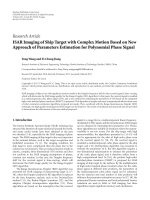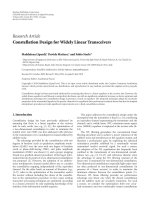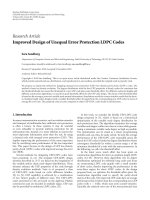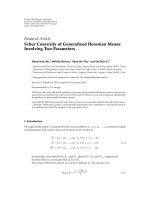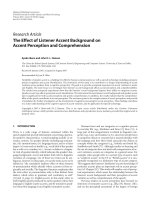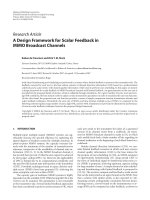Báo cáo hóa học: " Research Article Noniterative Design of 2-Channel FIR Orthogonal Filters" pptx
Bạn đang xem bản rút gọn của tài liệu. Xem và tải ngay bản đầy đủ của tài liệu tại đây (602.59 KB, 7 trang )
Hindawi Publishing Corporation
EURASIP Journal on Advances in Signal Processing
Volume 2007, Article ID 45816, 7 pages
doi:10.1155/2007/45816
Research Article
Noniterative Design of 2-Channel FIR Orthogonal Filters
M. Elena Dom
´
ınguez Jim
´
enez
TACA Research Group, ETSI Industriales, Universidad Polit
´
ecnica de Madrid, 28006 Madrid, Spain
Received 1 January 2006; Revised 12 June 2006; Accepted 26 August 2006
Recommended by Gerald Schuller
This paper addresses the problem of obtaining an explicit expression of all real FIR paraunitary filters. In this work, we present a
general parameterization of 2-channel FIR orthogonal filters. Unlike other approaches which make use of a lattice structure, we
show that our technique designs any orthogonal filter directly, with no need of iteration procedures. Moreover, in order to design
an L-tap 2-channel paraunitary filterbank, it suffices to choose L/2 independent parameters, and introduce them in a simple ex-
pression which provides the filter coefficients directly. Some examples illustrate how this new approach can be used for designing
filters with certain desired properties. Further conditions can be eventually imposed on the parameters so as to design filters for
specific applications.
Copyright © 2007 M. Elena Dom
´
ınguez Jim
´
enez. This is an open access article distributed under the Creative Commons
Attribution License, which permits unrestricted use, distribution, and reproduction in any medium, provided the original work is
properly cited.
1. INTRODUCTION
Filterbanks are widely used in all sig nal processing areas. In
the 2-channel case, the filterbank decomposes any signal into
its lowpass and highpass components; this is achieved by
convolution with a lowpass filter h and a highpass filter g.
When using finite impulse response (FIR) filters, the imple-
mentation is even more direct.
In particular, for signal compression applications, or-
thogonal subband transforms are desired; hence, paraunitary
filterbanks are required. Thus, some design techniques have
been addressed in the literature. Moreover, the appearance
of the wavelet theory gave a new insight into the filter bank
theory, and also provided new methods for the design of real
FIR paraunitary filters.
Despite the wide number of publications, we have fo-
cused on the most well-known results, which are contained
in [1–5]. We can merge these main approaches into three
groups.
(a) Methods bas ed on spectral factorizations. Commonly
used in wavelet theory [1, 3], they are based on the
following characterization: a real L-tap filter h
=
(h
1
, h
2
, , h
L
) is paraunitary if and only if its transfer
function H(z)
=
L
n
=1
h
n
z
1−n
verifies
H(z)
2
+
H(−z)
2
= 2, |z|=1. (1)
Hence, it sufficestofindthepowerspectralP(z)
=
|
H(z)|
2
which satisfies P(z)+P(−z) = 2, and then
factors it as P(z)
=|H(z)|
2
= H(z)H(z
−1
)soasto
get the real filter coefficients. Thus, it is necessary to
compute roots of a 2L
− 1degreepolynomialP;but
the main drawback is that the corresponding iterative
algorithms generally become numerically unstable for
long filters.
(b) Lattice filters desig n. Instead of computing a polyno-
mial, this approach designs the polyphase matrix asso-
ciated with the FIR 2-channel cell given by filters h, g.
The polyphase matrix is defined as
H
p
(z) =
H
even
(z) H
odd
(z)
G
even
(z) G
odd
(z)
(2)
and the filterbank is paraunitary if and only if H
p
(z)
is unitary for every
|z|=1. Thus, it suffices to build
unitary matrices of this kind. The paradigm of these
methods is Vaidyanathan’s algorithm [2, 6, 7]. Basi-
cally, any paraunitary real L-tap FIR causal filter is ob-
tained through iteration, because its polyphase matrix
can be factorized as
H
p
(z) =
L/2 −1
j=1
I +
z
−1
− 1
v
j
v
t
j
Q,(3)
2 EURASIP Journal on Advances in Signal Processing
where Q is unitary of order 2, and v
j
are unitary col-
umn vectors of
R
2
. Thus, in order to design a parau-
nitary filter of length L,weneedatotalamountofL/2
parameters in [
−1, 1], and L/2 signs. This algorithm
behaves well numerically, but it is difficult to apply
when imposing extra desired properties upon the fil-
ter. Besides, as we will see later on, this representation
is redundant, in the sense that it could eventually give
rise to filters of smaller length L
− 2.
(c) Lifting scheme [5, 8]. this is apparently another ap-
proach for either orthogonal or biorthogonal two-
channel filter banks. The key idea is to build filters of
length L with desirable properties by lift ing filters of
length smaller than L. But, for the orthogonal case [5],
it turns out to be another iterative algor ithm, equiv-
alent to the lattice factorization already mentioned.
Thus, we w ill consider it as a particular example of the
lattice filters design approach.
We summarize that all these well-known approaches
present some disadvantages.
On the other hand, in our recent work [9]wehavepro-
posed the first parameterization for paraunitary filters of
length L by means of only L/2 independent parameters and
1 sign; besides, the filter coefficients are obtained explicitly,
using neither an iteration process nor a root finding proce-
dure. In this paper, we improve our design technique, by ob-
taining a simpler expression; we also make for the first time
a rigorous proof of its validity for lowpass filters. Finally, as
one of the main contributions, we present a novel explicit ex-
pression of the power spectral response P(z) of paraunitar y
filters. It constitutes a new tool for the design of filters. For
each specific application, it may be used to design the parau-
nitary filter to satisfy the desired properties.
The paper is organized as follows: in Section 2 we de-
rive the explicit expression of all real 2-channel FIR orthog-
onal filterbanks. In Section 3 we study the particular case of
lowpass paraunitary filterbanks, and illustrative examples are
shown. In Section 4 we obtain the general explicit expression
of the halfband power spectral response of a paraunitary fil-
ter, by means of the free parameters; conclusions are finally
discussed in Section 5.
Let us now introduce the following notation, necessary to
follow the development of our work: for any set of real num-
bers (a
1
, , a
m
), let us denote the Toeplitz low-triangular
matrix of order m which contains these numbers in its first
column,
T
a
1
, , a
m
=
⎛
⎜
⎜
⎜
⎜
⎜
⎜
⎜
⎜
⎜
⎝
a
1
00··· 0
a
2
a
1
0
.
.
.
.
.
.
a
3
a
2
a
1
.
.
.
.
.
.
.
.
.
.
.
.
.
.
.
.
.
.
0
a
m
··· a
3
a
2
a
1
⎞
⎟
⎟
⎟
⎟
⎟
⎟
⎟
⎟
⎟
⎠
. (4)
Throughout this paper, only real matrices and vectors are
considered. Matrices are denoted by capital letters, and vec-
tors by boldface lowercase letters. The superscript t denotes
transposition.
Finally, P will denote the exchange matrix, say, the one
that produces a reversal. Recall that any Toeplitz matrix T
verifies PTP
= T
t
.Ineffect, by reversing the order of its rows
and columns we obtain its transpose.
2. NEW EXPRESSION OF ORTHOGONAL FILTERS
Throughout this paper, we will say that an L-tap filter h is
orthogonal if it is orthogonal to its even shifts, that is, if it
satisfies
∀k = 1, ,
L
2
− 1, 0 =
L−2k
n=1
h
n
h
n+2k
. (5)
If we additionally impose the norm 1 condition (
L
n
=1
h
2
n
=
1), then h w ill be called par aunitary.
The orthogonality condition implies that L is even; then,
(5) can be rewr itten, for any k
= 1, , L/2 − 1, as
n odd
h
n
h
n+2k
=−
n even
h
n
h
n+2k
. (6)
For instance, if k
= L/2 −1, we have that h
1
h
L−1
=−h
2
h
L
;as
h
1
· h
L
= 0, there must be a real parameter a
1
such that
h
L−1
h
L
=−
h
2
h
1
= a
1
. (7)
Hence,
h
2
=−a
1
h
1
, h
L−1
= a
1
h
L
. (8)
In other words, h
2
, h
L−1
can be derived from h
L
, h
1
,respec-
tively.
Now the key question arises: can we always write the even
components of the filter by means of the odd ones, and vice
versa? In [9], we have proved the next result, which guaran-
tees that the answer is yes. Its demonstration is also included
here.
Theorem 1. h
= (h
1
, h
2
, , h
L
) is an orthogonal real fil-
ter if and only if there exi sts a unique set of real numbers
a
1
, , a
L/2 −1
such that, for any k = 1, , L/2 − 1,
h
2k
=−
k
j=1
h
2k+1−2 j
a
j
, h
L+1−2k
=
k
j=1
h
L−2k+2 j
a
j
. (9)
Or, in an equivalent mat ricial way,
⎛
⎜
⎜
⎜
⎜
⎝
h
2
h
4
.
.
.
h
L−2
⎞
⎟
⎟
⎟
⎟
⎠
=−
T
a
1
, , a
L/2 −1
⎛
⎜
⎜
⎜
⎜
⎝
h
1
h
3
.
.
.
h
L−3
⎞
⎟
⎟
⎟
⎟
⎠
, (10)
⎛
⎜
⎜
⎜
⎜
⎝
h
3
.
.
.
h
L−3
h
L−1
⎞
⎟
⎟
⎟
⎟
⎠
=
T
a
1
, , a
L/2 −1
t
⎛
⎜
⎜
⎜
⎜
⎝
h
4
.
.
.
h
L−2
h
L
⎞
⎟
⎟
⎟
⎟
⎠
. (11)
M. Elena Dom
´
ınguez Jim
´
enez 3
Proof. Equation (5) may be easily rewritten matricially as
T
h
1
, h
3
, , h
L−3
⎛
⎜
⎜
⎜
⎜
⎝
h
L−1
h
L−3
.
.
.
h
3
⎞
⎟
⎟
⎟
⎟
⎠
=−
T
h
L
, h
L−2
, , h
4
⎛
⎜
⎜
⎜
⎜
⎝
h
2
h
4
.
.
.
h
L−2
⎞
⎟
⎟
⎟
⎟
⎠
,
(12)
where we have used our notation for lower triangular
Toeplitz matrices. As h
1
·h
L
= 0, both matrices are nonsingu-
lar; besides, their inverses are also lower triangular Toeplitz
matrices; finally, such matrices always commute, so we can
state that
T
h
L
, h
L−2
, , h
4
−1
⎛
⎜
⎜
⎜
⎜
⎝
h
L−1
h
L−3
.
.
.
h
3
⎞
⎟
⎟
⎟
⎟
⎠
=−
T
h
1
, h
3
, , h
L−3
−1
⎛
⎜
⎜
⎜
⎜
⎝
h
2
h
4
.
.
.
h
L−2
⎞
⎟
⎟
⎟
⎟
⎠
=
⎛
⎜
⎜
⎜
⎜
⎝
a
1
a
2
.
.
.
a
L/2 −1
⎞
⎟
⎟
⎟
⎟
⎠
;
(13)
in other words, we define (a
1
, , a
L/2 −1
)
t
as any of these two
vectors. For instance, the first coefficient a
1
is the one that
verifies a
1
= h
L−1
/h
L
=−h
2
/h
1
. Thus, we simultaneously
have
⎛
⎜
⎜
⎜
⎜
⎝
h
2
h
4
.
.
.
h
L−2
⎞
⎟
⎟
⎟
⎟
⎠
=−
T
h
1
, h
3
, , h
L−3
⎛
⎜
⎜
⎝
a
1
.
.
.
a
L/2 −1
⎞
⎟
⎟
⎠
,
⎛
⎜
⎜
⎜
⎜
⎝
h
L−1
h
L−3
.
.
.
h
3
⎞
⎟
⎟
⎟
⎟
⎠
=
T
h
L
, h
L−2
, , h
4
⎛
⎜
⎜
⎝
a
1
.
.
.
a
L/2 −1
⎞
⎟
⎟
⎠
.
(14)
Note also that the set of parameters (a
j
)
L/2 −1
j
=1
which satisfies
any of these conditions is unique. Besides, these equations
are equivalent to
⎛
⎜
⎜
⎜
⎜
⎝
h
2
h
4
.
.
.
h
L−2
⎞
⎟
⎟
⎟
⎟
⎠
=−
T
a
1
, , a
L/2 −1
⎛
⎜
⎜
⎜
⎜
⎝
h
1
h
3
.
.
.
h
L−3
⎞
⎟
⎟
⎟
⎟
⎠
,
⎛
⎜
⎜
⎜
⎜
⎝
h
L−1
h
L−3
.
.
.
h
3
⎞
⎟
⎟
⎟
⎟
⎠
=
T
a
1
, , a
L/2 −1
⎛
⎜
⎜
⎜
⎜
⎝
h
L
h
L−2
.
.
.
h
4
⎞
⎟
⎟
⎟
⎟
⎠
.
(15)
The former i dentity yields (10) directly. On the other
hand, by reversing the rows of the second identity we obtain
(11). Just recall that T(a
1
, , a
L/2 −1
) is a Toeplitz matrix, so
the exchange matrix P satisfies
PT
a
1
, , a
L/2 −1
=
T
a
1
, , a
L/2 −1
t
P, (16)
which concludes the proof.
For example, for k = 2, Theorem 1 implies that h
L−3
=
a
1
h
L−2
+ a
2
h
L
and −h
4
= a
1
h
3
+ a
2
h
1
. So we have shown that
it is possible to express every odd coefficient h
2k+1
by means
of its following even coefficients of the filter, and every even
coefficient h
2k
by means of its former odd ones.
2.1. New simplified expression of orthogonal filters
Once we have demonstrated the existence of the vector of pa-
rameters a
= (a
j
)
L/2 −1
j
=1
, then we define
(i) a Toeplitz low-triangular matrix of order L/2
− 1:
A :
= T
0, a
1
, , a
L/2 −2
; (17)
(ii) andtwovectorsoflengthL/2
− 1:
b
=−
I + AA
t
−1
a,
c
= A
t
b =−A
t
I + AA
t
−1
a,
(18)
which are well defined because I + AA
t
is always a
positive definite matrix. Note also that b
1
=−a
1
and
c
L/2 −1
= 0 because of the null diagonal of A.
For the sake of simplicity, from now on we will denote
h
even
=
h
2
, h
4
, h
6
, , h
L−2
t
,
h
odd
=
h
3
, h
5
, , h
L−3
, h
L−1
t
,
(19)
which contain the even and odd indexed coefficients of h ex-
cept the first and the last ones, h
1
, h
L
.
Now we are able to finally express all the components of
the filter by means of h
1
, h
L
, and the L/2−1 parameters. This
is one of the main results of this paper, which constitutes a
new characterization and design method of all orthogonal
filters, even simpler than the one obtained in [9].
Theorem 2. h
=(h
1
, h
2
, , h
L
) is an orthogonal filter if and
only if there exist L/2
−1 real numbers a
1
, , a
L/2 −1
such that
h
even
= h
1
b + h
L
Pc, h
odd
= h
1
c − h
L
Pb. (20)
Proof. By making use of the matrix A and the vectors h
even
and h
odd
introduced above, (10)and(11)canbe,respectively,
rewritten as
−h
even
= h
1
a + Ah
odd
, h
odd
= h
L
Pa + A
t
h
even
(21)
so we have that
h
even
+ Ah
odd
=−h
1
a, −A
t
h
even
+ h
odd
= h
L
Pa.
(22)
4 EURASIP Journal on Advances in Signal Processing
It just suffices to solve this linear system with unknowns
h
even
, h
odd
. By elementary Gaussian elimination operations,
it is equivalent to the system
I + AA
t
h
even
=−
h
1
I+h
L
AP
a,
I + A
t
A
h
odd
=
h
L
P − h
1
A
t
a,
(23)
from which we can obtain both vectors independently, be-
cause I + AA
t
and I + A
t
A are nonsingular. Moreover, we can
exploit the fact that A is Toeplitz: A
t
= PAP, A = PA
t
P,and
A
t
A = PAA
t
P so (I + A
t
A) = P(I + AA
t
)P and
I + A
t
A
−1
P = P
I + AA
t
−1
; (24)
besides, it is easy to show that
I + AA
t
−1
A = A
I + A
t
A
−1
,
I + A
t
A
−1
A
t
= A
t
I + AA
t
−1
.
(25)
Finally, we make use of all these expressions and the defi-
nition of b and c giveninexpressions(18)inordertoobtain
(20):
h
even
=−
I + AA
t
−1
h
1
I+h
L
AP
a = h
1
b + h
L
Pc,
h
odd
=
I + A
t
A
−1
h
L
P − h
1
A
t
a =−h
L
Pb + h
1
c.
(26)
We have derived that, by choosing L/2 − 1 arbitrary pa-
rameters and 2 arbitr ary nonzero numbers h
1
, h
L
,weareable
to parameterize the whole set of orthogonal filters h of length
L. In other words, these filters are characterized by means of
just L/2 + 1 parameters. And this representation is unique:
different sets of parameters always yield different filters, so
there is no redundancy in this parameterization.
All the coefficients of the filter are of the following form
(first: odd coefficients, last: even coefficients):
⎛
⎜
⎜
⎜
⎝
h
1
h
odd
h
even
h
L
⎞
⎟
⎟
⎟
⎠
=
⎛
⎜
⎜
⎜
⎝
10
c
−Pb
b Pc
01
⎞
⎟
⎟
⎟
⎠
h
1
h
L
. (27)
Thus, any orthogonal filter is a linear combination of
these two columns, which are indeed orthogonal filters of
length L
− 2. They are orthogonal columns; moreover, it can
easily be seen that they are conjugate quadrature filters. In
effect, the odd components of the first filter correspond to
the even components of the second one, reversed; and the
even components of the first filter are the opposite of the odd
components of the second one, reversed. T his property will
be exploited in the next section.
Let us remark that this propert y confirms the underlying
idea of lattice factorization [6] and lifting scheme [5]. L-tap
paraunitary filters can be built by means of paraunitary filters
of smaller length (L
− 2). In this sense, our design approach
generalizes those existing techniques.
To finish this section, let us notice that we can also write
h
odd
Ph
even
=
c −Pb
h
1
h
L
h
L
−h
1
. (28)
Remark 1. From this expression, we also deduce that any
pair of conjugate quadrature mirror filters is associated to
the same set of independent parameters a
1
, , a
L/2 −1
; the only
difference is the value of the first and last coefficients. If we
choose h
1
, h
L
for the filter h, then we just have to set g
1
= h
L
,
g
L
=−h
1
for its CQM filter g.
2.2. New expression of paraunitary filters
Next, we impose the constraint that the vector h has norm 1;
regarding (27), let us note that the norm of each column is
equal to
1+
b
2
+ c
2
= 1 −b
t
a ≥ 1, (29)
wherewehaveusedthat
b
2
+
A
t
b
2
= b
t
I + AA
t
b =−b
t
a ≥ 0. (30)
Due to the orthogonality of the two columns of this ex-
pression (27), the norm of h is very easy to compute:
1
=h
2
=
1 − b
t
a
h
2
1
+ h
2
L
. (31)
As the quantity 1
≤ 1 −b
t
a < ∞ and only depends on the
election of the parameters, it just suffices to choose h
1
, h
L
in
the circle of radius
0 <
1
√
1 − b
t
a
≤ 1. (32)
Corollary 1. h
=(h
1
, h
2
, , h
L
) is a paraunitary filter if and
only if there exist L/2
− 1 real numbers a
1
, , a
L/2 −1
verifying
(20),and
h
2
1
+ h
2
L
=
1 − b
t
a
−1
. (33)
This means that h
L
(up to its sign) is expressed by means of h
1
.
In other words, it is deduced that the set of paraunitary filters of
length L is determined by L/2 parameters, and 1 sign.
For instance, if all the parameters are chosen null, then
vectors b and c are null, and the filter obtained is of the type
h
= (h
1
,0, ,0,h
L
) which is orthogonal, and unitary when-
ever h
2
1
+ h
2
L
= 1/(1 + 0
2
+0
2
+0
2
) = 1.
3. DESIGN OF ORTHOGONAL FILTERS WITH
DESIRABLE PROPERTIES
3.1. Design of lowpass orthogonal filters
Lowpass filters must satisfy H(1)
= s = 0. Equivalently, let
us now impose s
= H(1) =
h
n
= u
t
h where u is the vector
whose components are all equal to 1. Again, by using (27),
the sum of the coefficients of h is a linear combination of the
sum of each one of the two columns:
s
= h
1
1+u
t
(b + c)
+ h
L
1+u
t
(c − b)
(34)
so we get the equation of a straight line. Note that the normal
vector is always nonzero, because the sum of both columns
cannot vanish simultaneously. The reason is that they are
M. Elena Dom
´
ınguez Jim
´
enez 5
conjugate quadrature mirror filters. Hence, there are always
infinite choices for h
1
, h
L
in that line.
For example, by choosing all parameters null, the equa-
tion of the line is s
= h
1
+ h
L
so the associated orthogonal
filter is h
= (h
1
,0, ,0,s −h
1
).
3.2. Design of lowpass paraunitary filters
It is well known that lowpass paraunitary filters must satisfy
the DC leakage condition. As H(
−1) = 0, introducing it into
(1) we obtain that H(1)
=
√
2. Now we impose both condi-
tions over the orthogonal filter h:norm1andsum
√
2.
The equations that h
1
, h
L
must verify are
h
2
1
+ h
2
L
=
1 − b
t
a
−1
,
√
2 = h
1
1+u
t
(b + c)
+ h
L
1+u
t
(−b + c)
.
(35)
In other words, (h
1
, h
L
) lies in the intersection between
a circle and a line in
R
2
. Maythisintersectionbenull? This
question was open in our previous work [9]butnowwe
demonstrate that the answer is no. The reason is that, for
any lowpass filter of first and last coefficients h
1
, h
L
, the cor-
responding conjugate highpass filter of the same length is
the one whose first and last coefficients are
±h
L
, ∓h
1
. This
means that the line which is orthogonal to the previous one
and contains the origin will surely intersect such circle in two
points:
±(h
L
, −h
1
). So there is only one highpass filter (up to
the sign); hence, there is only one lowpass orthogonal filter
which satisfies both conditions above. So this justifies that
such intersection is not null, moreover, it contains only one
point.
For example, if all the parameters are chosen to be
null, then all these vectors are null, and this condition is
clearly satisfied, giving r ise to the paraunitary lowpass filters
±
√
2/2(1, 0, 0, ,0,0,1);forL = 2, we obtain the Haar filter.
3.3. Example: 4-tap lowpass paraunitary filters
As a ver y simple example, let us consider paraunitary fil-
ters of length 4; they must be of the following form: h
=
(h
1
, −ah
1
, ah
4
, h
4
), they must have norm 1, and satisfy the
DC condition:
h
2
1
+ h
2
4
=
1+a
2
−1
,
√
2 = h
1
(1 − a)+h
4
(1 + a).
(36)
But such conditions are always possible for all a
1
, since the
line and the circle intersect in only one point,
h
1
=
(1 − a)
1+a
2
√
2
, h
4
=
(1 + a)
1+a
2
√
2
(37)
obtaining the unique expression for the filter
h
=
1
1+a
2
√
2
1 − a, a
2
− a, a
2
+ a,1+a
. (38)
Let us compare it to the other approaches. The spectral
method would have required a greater amount of operations;
as for the lattice filters, we only would need 4/2
− 1 = 1 uni-
tary vector, and a unitary matrix of order 2. It is easy to see
that the unitary matrix for lowpass filters is always equal to
Q
=
√
2
2
11
1
−1
. (39)
Next, by choosing an arbitrary unitary vector v
= (c, d)
t
/
√
c
2
+ d
2
and the unitary matrix Q, the paraunitary lowpass
filters computed via the lattice method are
h
=
1
c
2
+ d
2
√
2
d
2
− cd, d
2
+ cd, c
2
+ cd, c
2
− cd
(40)
so they are of length 4, except when c
= 0 (and we have Haar
filter), or d
= 0orc = d (shifted versions of Haar filter).
This is an example that the lattice design may provide filters
of smaller length.
On the other hand, note that its components are h
=
(h
1
, −ah
1
, ah
4
, h
4
) with (in case the length is exactly 4)
a
=
c + d
c − d
=
1+d/c
1 − d/c
(41)
and the ratio d/c is the very important direction of vector v,
whereas a
∈ R is a free parameter which can take all possible
real values. This means that our expression (38) is simpler
than (40), and yields the same set of paraunitary filters.
3.4. Example: 4-tap lowpass paraunitary filter
with maximum attenuation
The attenuation of the lowpass filter may be measured as
π/2
0
H(w)
2
dw =
π
2
+2
L/2 −1
n=0
r(2n +1)
(
−1)
n
(2n +1)
, (42)
where r(n) denotes the autocorrelation coefficients of the fil-
ter.
Let us impose now the maximum attenuation to our 4-
tap designed filters. In this case we should maximize r(1)
−
r(3)/3. To this aim, we compute such autocorrelation coeffi-
cients of (38):
r(1)
=
3a
2
+ a
4
1+a
2
2
2
, r(3)
= h
1
h
4
=
1 − a
2
1+a
2
2
2
. (43)
Next, it suffices to maximize
r(1)
−
r(3)
3
=
10a
2
+3a
4
− 1
6
1+a
2
2
. (44)
We obtain that the maximum is achieved for a
=±
√
3. For
a
=
√
3, we have
h
=
1
4
√
2
1 −
√
3, 3 −
√
3, 3 +
√
3, 1 +
√
3
, (45)
whereas for a
=−
√
3, we obtain
h
=
1
4
√
2
1+
√
3, 3 +
√
3, 3 −
√
3, 1 −
√
3
(46)
6 EURASIP Journal on Advances in Signal Processing
which correspond to the 4-tap Daubechies filters (mini-
mum/maximum phase), which are the optimal ones, with
attenuation (π/2) + (7/6).
Let us remark that our technique confirms the results ob-
tained by means of other approaches, although in a more
direct w ay. Nevertheless, working with longer filters will in-
volve maximizing a functional which depends on more vari-
ables, and the expressions will be more complicated.
4. NEW EXPRESSION OF THE POWER
SPECTRAL RESPONSE
As another final contribution, we will find the explicit expres-
sion of the halfband polynomial P(z)
=|H(z)|
2
associated to
a paraunitary filter of length L. Our final aim would be to de-
sign the polynomial P instead of the filter itself. To this end,
we first must find the desired expression of P by means of the
L/2
− 1 independent parameters (a
1
, , a
L/2 −1
), apart from
h
1
, h
L
which verify the 1-norm condition (33).
We will use the simple expression (27) already obtained.
LetusdenoteH
1
(z) the transfer function of the filter given by
the first column. On one hand, its even coefficients constitute
vector b, w hile its odd coefficients are (1, c). Note that it is a
filter of length L
− 2 because the last component of c is zero.
So we can write H
1
(z) = C(z
2
)+z
−1
B(z
2
), where B, C are the
respective transfer functions associated to the filters b,and
(1, c), both of length L/2
− 1.
Moreover, this first column constitutes an orthogonal fil-
ter; in effect, the filter
|H
1
(z)|
2
is halfband:
d
= 2
1 − b
t
a
=
H
1
(z)
2
+
H
1
(−z)
2
= 2
C
z
2
2
+2
B
z
2
2
.
(47)
On the other hand, the second column is a shifted version
of its CQF filter, so we easily deduce that
H(z)
= h
1
H
1
(z)+h
L
z
1−L
H
1
− z
−1
. (48)
Let us finally compute the power spectral response, also
by making use of (33):
P(z)
=
H(z)
2
=
h
1
H
1
(z)+h
L
z
1−L
H
1
− z
−1
2
=
h
2
1
+ h
2
L
d
2
+2h
1
h
L
Re
z
L−1
H
1
(−z)H
1
(z)
+2
h
2
1
− h
2
L
Re
zC
z
2
B
z
−2
=
1+2h
1
h
L
Re
z
L−1
C
z
2
2
− z
−2
B
z
2
2
+2
h
2
1
− h
2
L
Re
zC
z
2
B
z
−2
,
(49)
where Re stands for real part of the complex number.
We summarize that the coefficients of P, which are the
autocorrelation coefficients r(n)ofthefilter,canbeeasilyob-
tained by means of the coefficients of C
2
and B
2
(resp., the
autoconvolution of (1, c), and the autoconvolution of b)and
the coefficients of C(z
2
)B(z
−2
) (say, the correlation between
(1, c)andb). Recall that all these vectors are computed di-
rectly from the free parameters a. Finally, h
L
is simply ob-
tained from h
1
by means of (33), up to a sign.
5. CONCLUSIONS
We have presented a novel characterization of real parauni-
tary FIR filterbanks. This provides a new method for the di-
rect design of this type of filters. Its main advantage is that it
does not need any iteration process. It just suffices to choose
arbitrary values of some parameters, and substitutes them
into a closed-form expression. We have also obtained the
general expression of lowpass paraunitary filters. Moreover,
the proposed technique helps us to design filters with desired
properties in a very simple and direct way, even more than
the existing techniques, as has been illustrated with 4-tap fil-
ters. For paraunitary filters of arbitrary length, we have also
obtained a simple explicit expression of its power spectral re-
sponse. This yields a new powerful tool for designing parau-
nitary filters which satisfy extra conditions, as it is usually
requested in specific applications.
ACKNOWLEDGMENTS
This work has been supported by UPM through the AYUDA
PUENTE reference AY05/11263, and by CICYT through
the Research Project DIPSTICK reference TEC2004-02551/
TCM.
REFERENCES
[1] I. Daubechies, Te n Lect ures on Wavelets, SIAM, Philadelphia, Pa,
USA, 1992.
[2] P. P. Vaidyanathan, Multirate Systems and Filter Banks, Prentice-
Hall, Englewood Cliffs, NJ, USA, 1993.
[3] M. Vetterli and J. Kovacevic, Wavelets and Subband Coding,
Prentice-Hall, Englewood Cliffs, NJ, USA, 1995.
[4] G. Strang and T. Nguyen, Wavelets and Filter Banks,Wellesley-
Cambridge Press, Wellesley, Mass, USA., 1996.
[5] I. Daubechies and W. Sweldens, “Factoring wavelet transforms
into lifting steps,” Journal of Fourier Analysis and Applications,
vol. 4, no. 3, pp. 247–269, 1998.
[6] P. P. Vaidyanathan, T. Q. Nguyen, Z. Doganata, and T. Sara-
maki, “Improved technique for design of perfect reconstruction
FIR QMF banks with lossless polyphase matrices,” IEEE Trans-
actions on Acoustics, Speech, and Signal Processing,vol.37,no.7,
pp. 1042–1056, 1989.
[7] S M.Phoong,C.W.Kim,P.P.Vaidyanathan,andP.Ansari,“A
new class of two-channel biorthogonal filter banks and wavelet
bases,” IEEE Transactions on Signal Processing,vol.43,no.3,pp.
649–665, 1995.
[8] J. Kovacevic and W. Sweldens, “Wavelet families of increasing
order in arbitrary dimensions,” IEEE Transactions on Image Pro-
cessing, vol. 9, no. 3, pp. 480–496, 2000.
[9] M. E. Dom
´
ınguez Jim
´
enez, “New technique for design of 2-
channel FIR paraunitary filter banks,” in Proceedings of the 7th
IASTED International Conference on Signal and Image Processing
(SIP ’05), pp. 220–225, Honolulu, Hawaii, USA, August 2005.
M. Elena Dom
´
ınguez Jim
´
enez 7
M. Elena Dom
´
ınguez Jim
´
enez was born in
Madrid, Spain, in 1969. She received the de-
gree in mathematical sciences from the Uni-
versidad Complutense de Madrid in 1992
and the Ph.D. degree from the Universidad
Polit
´
ecnica de Madrid in 2001. She works as
an Assistant Professor at the ETSII Depar-
tament of Applied Mathematics of the Uni-
versidad Polit
´
ecnica de Madrid. Since 2005,
she also belongs to the Research Group
TACA of the same University. Her research interests include wavelet
theory, filter design, multiresolution signal processing, and audio
compression. She obtained an Extr aordinary Award f rom the Uni-
versidad Polit
´
ecnica de Madrid for the best doctoral dissertation
during 2001.

